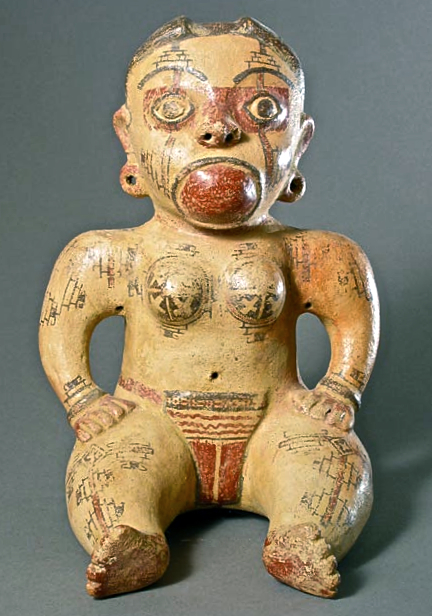

Title: Ancient Galo Polychrome Seated Female Mother Goddess Figure
Shipping: $29.00
Artist: N/A
Period: Unassigned
History: N/A
Origin: N/A
Condition: Museum Quality
Item Date: N/A
Item ID: 6382
Galo Polychrome Seated Female Figure. Origin: Costa Rica (Guanacaste) Circa: 500 AD to 800 AD Dimensions: 11.5" (29.2cm) high Collection: Pre-Columbian Medium: Terracotta "Looking back so many thousands of years, it seems as if humanity's first image of life was the mother. This must go back to a time when human beings experienced themselves as the children of nature, in relationship with all things, part of the whole." (Baring and Cashford, The Myth of the Goddess) Baring and Cashford are referring to the oldest sculpture of a Goddess, from about 22,000 B.C. from Brassempouy in the Landes area of France. They also state, "It is not surprising that these images of the Goddess appear throughout history, for they all express a similar vision of life on earth, one where the creative source of life is conceived in the image of a mother and where humanity feels itself and the rest of creation to be the mother's children." This beautiful female who sits before us may be a representation of a 'Mother Goddess,' as well. The lines etched around the outside of her breasts and the designs surrounding them direct attention to the sacred source. The center focus is directed to the nourishment of the flowing breast. The central theme of nourishment is all- inclusive. The shape of her full breasts and the swelling curves of her hips with the hole for the belly button, all emphasize the feeling of fecundity. A distinct division of her legs open at the entrance to the womb. The rippling movement of water painted above her womb suggests the source of the vegetative world and also of the waters of life. The geometric designs covering her voluptuous body may symbolize the sacred way of approach to a dimension invisible to human senses. "All these form an enduring constellation of images related to the figure of the Goddess, for they symbolize the intricate pathway that connects the visible world to the invisible, of the kind that souls of the dead would have taken to re-enter the womb of the Mother." (Baring and Cashford) The mouth is a peculiar part of this remarkable figure. Could this be an egg? The egg is also related to water as the primordial element in which life gestates. The egg and the womb are both images of the beginning of life. If she represents the mythical image from which creation emerged, she is surely one of the most beautiful goddesses in the enchanted world of fertility and birth. We are committed to enhancing our customer’s lives by discovering creating, and pointing out only the best art we can find in the world today. We Are Taste-Makers, Art Advisers, Consultants & Publishers Of Spectacular Art Stories. Our job is to be intermediaries between buyers and sellers. We are vetting for high end art patrons. We are determined to catalog the world's most exceptional art and share it with everyone.
Link: http://en.wikipedia.org/wiki/Indigenous_peoples_of_the_Americas
The indigenous peoples of the Americas are the pre-Columbian inhabitants of North and South, and Central America, and their descendants. Pueblos indígenas (indigenous peoples) is a common term in Spanish-speaking countries. Aborigen (aboriginal/native) is used in Argentina, whereas "Amerindian" is used in Guyana but not commonly in other countries. Indigenous peoples are commonly known in Canada as Aboriginal peoples, which include First Nations, Inuit, and Métis peoples. Indigenous peoples of the United States are commonly known as Native Americans or American Indians, and Alaska Natives.
According to the prevailing New World migration model, migrations of humans from Eurasia to the Americas took place via Beringia, a land bridge which connected the two continents across what is now the Bering Strait. The majority of authorities agree that the earliest migration via Beringia took place at least 13,500 years ago, with disputed evidence that people had migrated into the Americas much earlier, up to 40,000 years ago.[citation needed] These early Paleo-Indians spread throughout the Americas, diversifying into many hundreds of culturally distinct nations and tribes. According to the oral histories of many of the indigenous peoples of the Americas, they have been living there since their genesis, described by a wide range of traditional creation accounts.